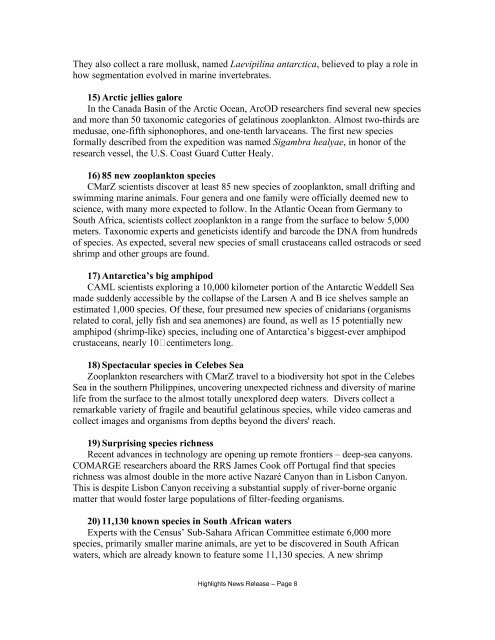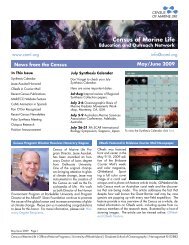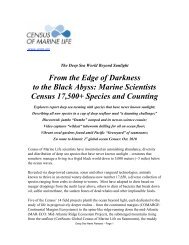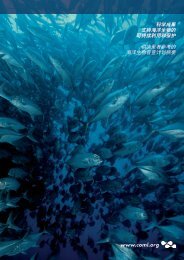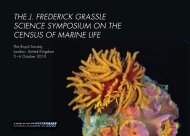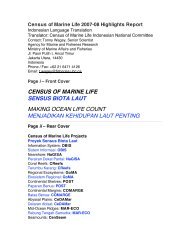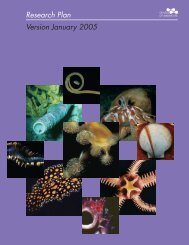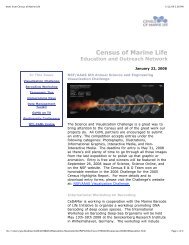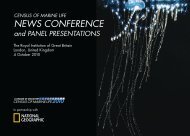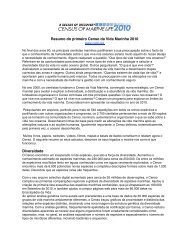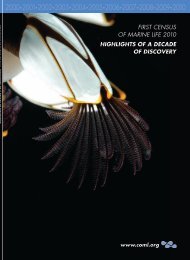Full press release - Census of Marine Life
Full press release - Census of Marine Life
Full press release - Census of Marine Life
Create successful ePaper yourself
Turn your PDF publications into a flip-book with our unique Google optimized e-Paper software.
They also collect a rare mollusk, named Laevipilina antarctica, believed to play a role inhow segmentation evolved in marine invertebrates.15) Arctic jellies galoreIn the Canada Basin <strong>of</strong> the Arctic Ocean, ArcOD researchers find several new speciesand more than 50 taxonomic categories <strong>of</strong> gelatinous zooplankton. Almost two-thirds aremedusae, one-fifth siphonophores, and one-tenth larvaceans. The first new speciesformally described from the expedition was named Sigambra healyae, in honor <strong>of</strong> theresearch vessel, the U.S. Coast Guard Cutter Healy.16) 85 new zooplankton speciesCMarZ scientists discover at least 85 new species <strong>of</strong> zooplankton, small drifting andswimming marine animals. Four genera and one family were <strong>of</strong>ficially deemed new toscience, with many more expected to follow. In the Atlantic Ocean from Germany toSouth Africa, scientists collect zooplankton in a range from the surface to below 5,000meters. Taxonomic experts and geneticists identify and barcode the DNA from hundreds<strong>of</strong> species. As expected, several new species <strong>of</strong> small crustaceans called ostracods or seedshrimp and other groups are found.17) Antarctica’s big amphipodCAML scientists exploring a 10,000 kilometer portion <strong>of</strong> the Antarctic Weddell Seamade suddenly accessible by the collapse <strong>of</strong> the Larsen A and B ice shelves sample anestimated 1,000 species. Of these, four presumed new species <strong>of</strong> cnidarians (organismsrelated to coral, jelly fish and sea anemones) are found, as well as 15 potentially newamphipod (shrimp-like) species, including one <strong>of</strong> Antarctica’s biggest-ever amphipodcrustaceans, nearly 10 centimeters long.18) Spectacular species in Celebes SeaZooplankton researchers with CMarZ travel to a biodiversity hot spot in the CelebesSea in the southern Philippines, uncovering unexpected richness and diversity <strong>of</strong> marinelife from the surface to the almost totally unexplored deep waters. Divers collect aremarkable variety <strong>of</strong> fragile and beautiful gelatinous species, while video cameras andcollect images and organisms from depths beyond the divers' reach.19) Surprising species richnessRecent advances in technology are opening up remote frontiers – deep-sea canyons.COMARGE researchers aboard the RRS James Cook <strong>of</strong>f Portugal find that speciesrichness was almost double in the more active Nazaré Canyon than in Lisbon Canyon.This is despite Lisbon Canyon receiving a substantial supply <strong>of</strong> river-borne organicmatter that would foster large populations <strong>of</strong> filter-feeding organisms.20) 11,130 known species in South African watersExperts with the <strong>Census</strong>’ Sub-Sahara African Committee estimate 6,000 morespecies, primarily smaller marine animals, are yet to be discovered in South Africanwaters, which are already known to feature some 11,130 species. A new shrimpHighlights News Release – Page 8


